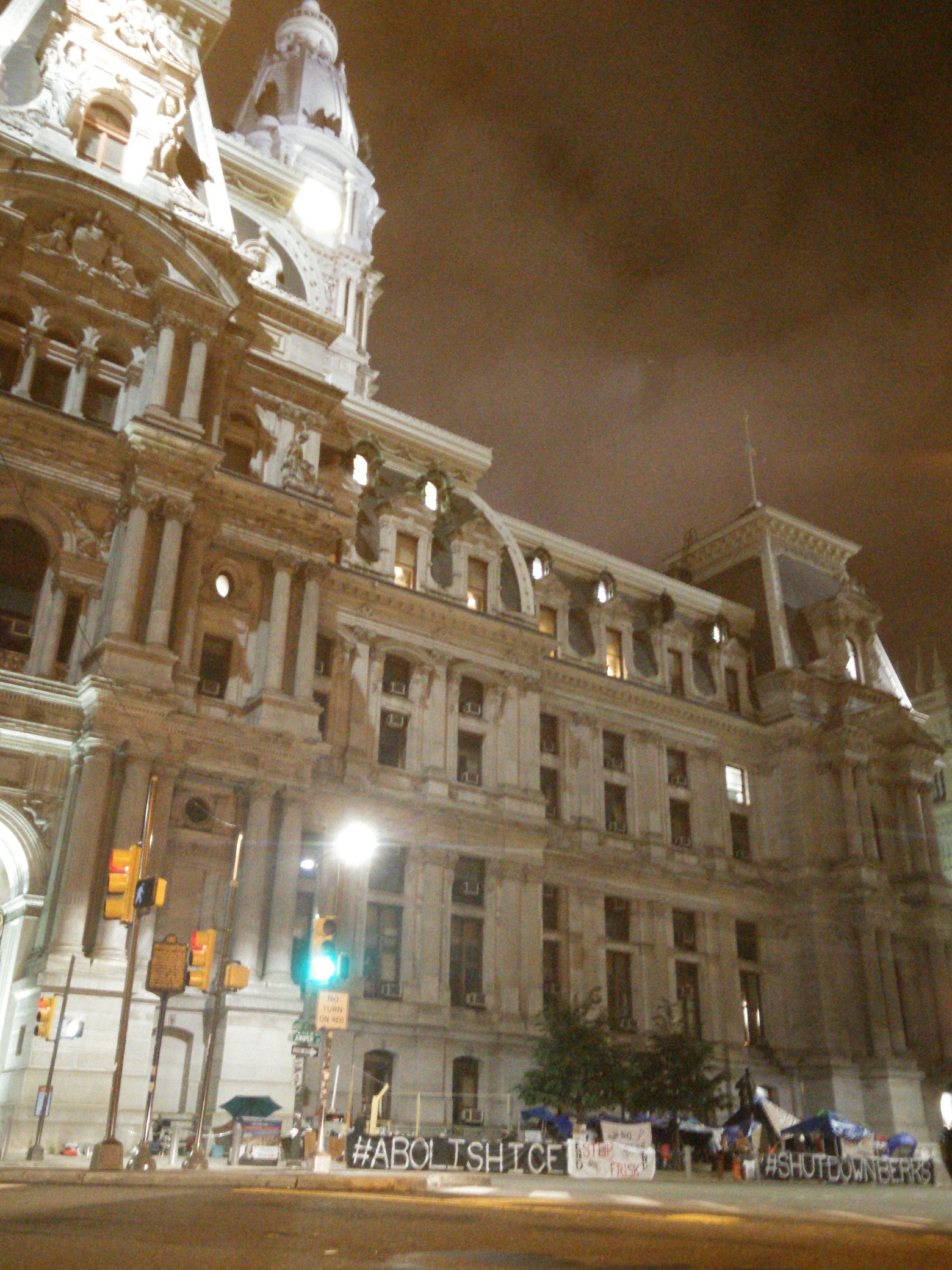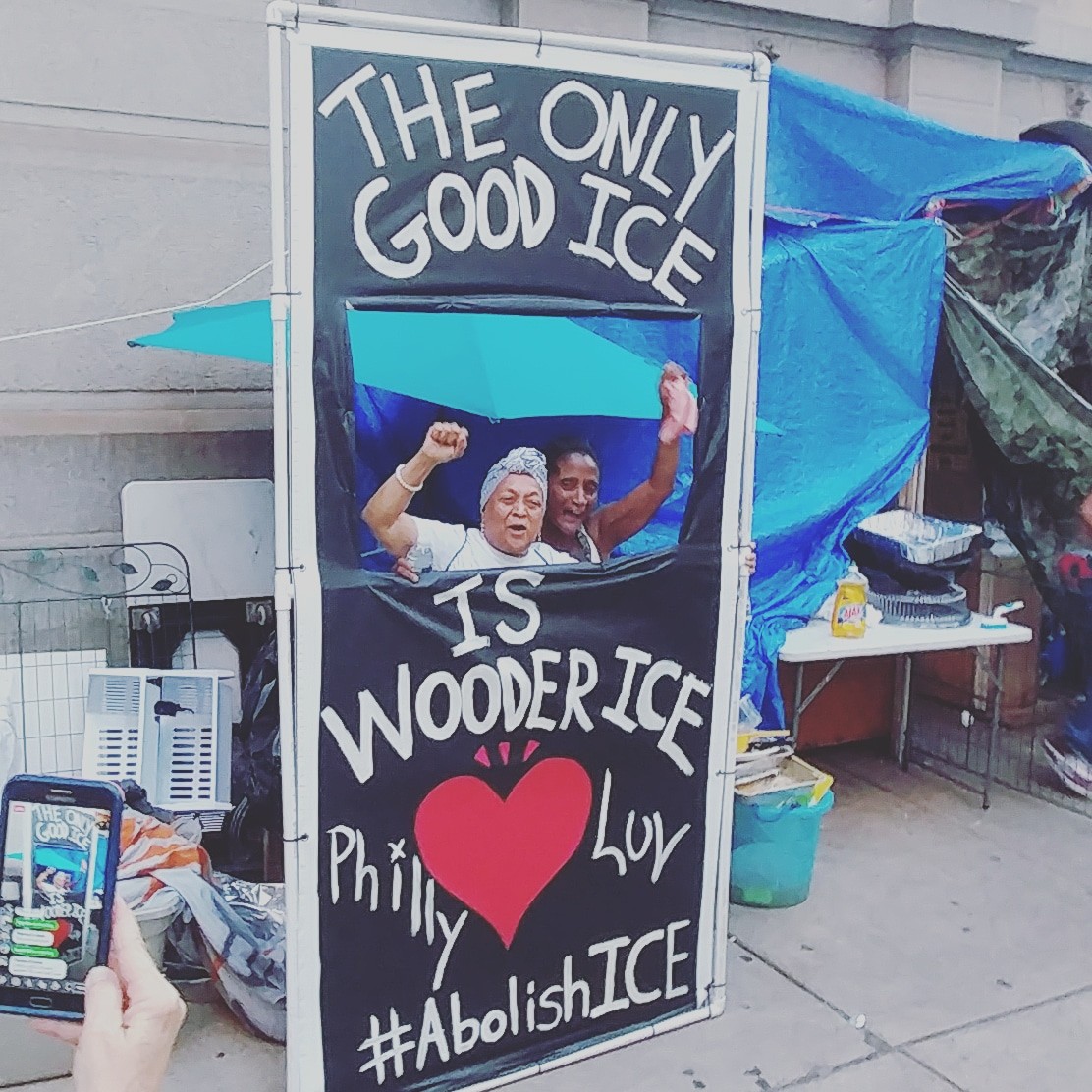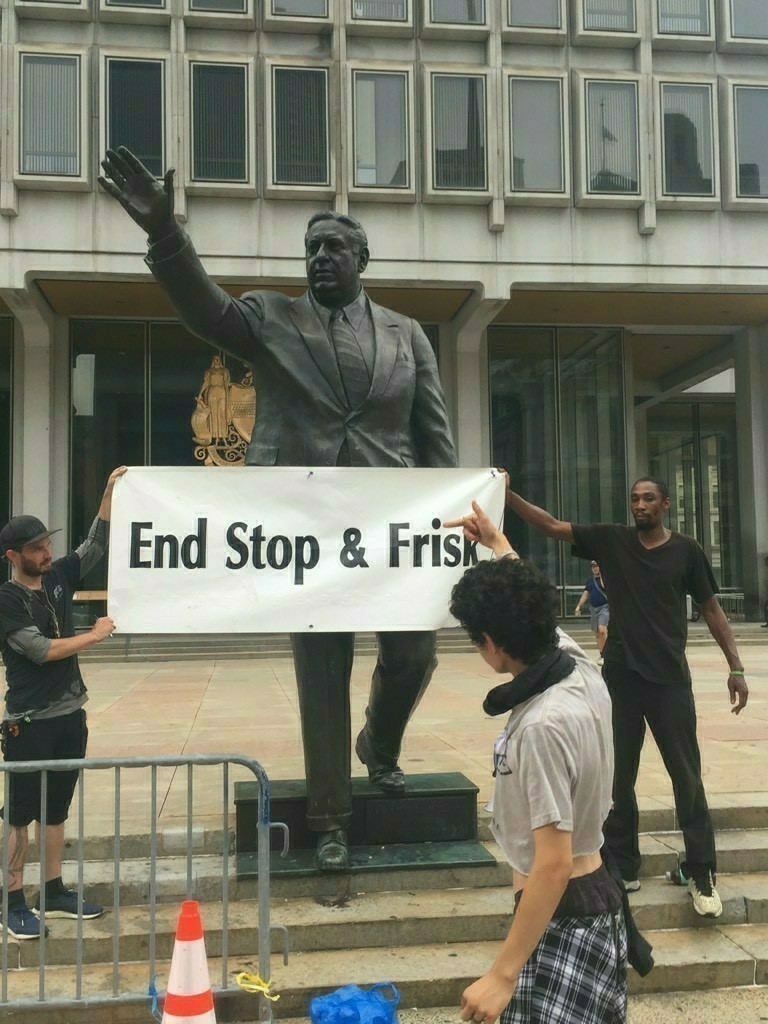Filed under: Action, Analysis, Anarchist Movement, Community Organizing, Featured, Housing, Immigration, Police, Solidarity

The following timeline and analysis traces the first month of activity at #OccupyICEPHL.
In the heat of struggle—and with the demands of security and safety—it’s very common that we don’t stop and record the actions, marches and political events occurring around us. Social movement historians often interview activists years after the fact, after nostalgia, popular sentiment and sectarian interpretations of the movement have hardened. As a result, we rarely get day by day accounts of movements until they can be reconstructed through official records, and thus have difficulty assessing the ebb and flow of tactics, escalations and direct actions that shape campaigns as they are ongoing.
It is with that in mind that we present this timeline of actions in and around OccupyICE Philadelphia that led to a major victory: the end of official data-sharing between ICE and the Philadelphia Police Department.
Timeline
July 2nd: After weeks of planning, a coalition of radical groups in Philadelphia hold a rally outside City Hall. Hundreds show up, and march to ICE offices at 8th and Cherry, where an occupation is spontaneously set up. At first the streets around the building are barricaded, but organizers negotiate with police to take down barricades and remain on the sidewalk, blocking the doors and driveways. This moment, in which activists in high-visibility vests are seen taking down the barricades at police demand—and an altercation between organizers afterwards—will be the source of ongoing tensions in the activist scenes of Philadelphia. Nevertheless, the space is bravely held and an occupation with tents and umbrellas is set up blocking ICE.
July 3rd: Police attack the encampment, arresting 29 protestors who link arms and stay in formation as they are arrested. PPD clears the main driveway and takes down all the structures. In defiance, protestors immediately rebuild, setting up umbrellas, tents and chairs in the intersection of 8th and Cherry Street. Jail support mobilizes. All arrested are released with citations.
July 4th: A vacation atmosphere pervades in camp as numbers swell with people off for the fourth. A small contingent marches down to Market Street to interrupt a July 4th parade. A banner reading “No one is illegal. Abolish ICE” is dropped from between two trees over 8th street. A GA is held.
July 5th: At around 12:00 PM, a hundred PPD attack and clear the rest of the camp, beating everyone, destroying materials, and arresting seven. A press conference arranged by the coalition for later that afternoon means there is a tremendous amount of local coverage of the attack. A GA held at 7PM draws more than 150 people, but core coalition organizers, burnt out from the last few days, announce their intention to decamp, and the GA ends in inaction. Meanwhile, however, a small contingent of protestors have set up a new encampment at City Hall to put pressure on the city to meet the movement’s first demand: end PARS, the data sharing agreement between PPD and ICE. A pamphlet critiquing camp organizers, “An Anarchist Report Back and Some Embedded Critiques of #OccupyICE Philadelphia”, is published.
 July 6th: Philadelphia Mayor Jim Kenney¬who campaigned on anti-Trump rhetoric and making Philadelphia a sanctuary city, takes a terrible beating in the press—thanks in large part to the publicity work of the coalition—for the attack on ICE protestors. This political pressure forces him to play nice, and he says publicly that the new encampment can stay. Where the first camp was surrounded at all times by police, PPD takes a hands off approach to the City Hall encampment.
July 6th: Philadelphia Mayor Jim Kenney¬who campaigned on anti-Trump rhetoric and making Philadelphia a sanctuary city, takes a terrible beating in the press—thanks in large part to the publicity work of the coalition—for the attack on ICE protestors. This political pressure forces him to play nice, and he says publicly that the new encampment can stay. Where the first camp was surrounded at all times by police, PPD takes a hands off approach to the City Hall encampment.
July 7th: The new encampment begins building out infrastructure. Banners and tarps go up. Posters are wheatpasted around downtown. A queer dance party is held at camp, pirating power from city hall.
July 8th: A newlywed immigrant couple comes down to camp in their wedding attire to demand Kenney end PARS and express solidarity and support. A number of unhoused folks who live in and around city hall join the movement and begin to call the camp home.
July 9th: Kenney meets with campers and immigrant rights activists, in particular organizers from Juntos, who have been waging the fight against PARS for almost a decade and who set the entire stage for this struggle, to discuss demands. The meeting is inconclusive, but rumors start to circulate that PARS’ days are numbered. A camp kitchen and first aid tent are established to help organize donations and activity.
Tonight! pic.twitter.com/6RVhZrmwQi
— AbolishICEPHL (@no_ice_PHL) July 10, 2018
July 10th: A mass meeting at the Friends center sees more than a hundred folks debating the way forward. At that meeting a mass march is called for August 4th. Twice daily General Assemblies are established at the camp.
July 11th: Philadelphia DA Larry Krasner calls for an end for ICE access to PARS, increasing the political pressure. A workshop at anarchist bookshop The Wooden Shoe, led and attended by camp organizers of different ideological stripes, calls for unity of action between socialist, communist and anarchist communities. Nevertheless, sectarian tension continues unabated within the activist scene. Meanwhile, tension increases between middle-class and unhoused organizers, as facts of life on the streets—fighting, drug use, serious mental illness—have to be dealt with at camp.
July 12th: The city requests a meeting with ICE officials on the future of PARS data sharing. A banner reading “End PARS /End Family Detention/Abolish ICE” is dropped out of a city hall window above the camp.
July 13th: City Council is called in for a closed special session to be briefed by the city’s legal team on PARS. Confidence grows inside camp and in the larger activist community that PARS will soon come to an end. Camp participates in #OneMillionFlames, a nationwide solidarity vigil for detained and deported families.
July 14th: DHS Director Kirstjen Nielsen gives a speech at the Loews Hotel and is heckled by occupiers. Protestors demonstrate and pass out literature outside the event.
July 15th: The Shut Down Berks coalition holds a vigil outside the Berks Detention Center. Around 250 people attend. Eleven protestors are arrested sitting in, blocking the road into the center.
July 16th: Over the weekend the makeup of the camp has decidedly swung towards unhoused activists. Many people who have been active in the first two weeks are burnt out and consider the camp too difficult to organize in. Simultaneously, however, the unhoused activists have gotten to know each other and have gotten organized, and the amount of drama and chaos at the camp begins to drop dramatically.
July 17th: Pressure continues to ramp on Kenney in the local press. Activists bring a screen printer to camp and make dozens of “Mayor Kenney end PARS” t-shirts. Friendly Fire Collective publishes “Beyond Occupation.” The West Philly Orchestra comes to camp and gives a concert.
 July 18th: The first of a number of “Noise Demos” occurs outside ICE offices during rush hour, as 25 or so activists shut down 8th and Cherry for a few hours and loudly disrupt ICE’s morning operations. The Kenney administration once again meets with ICE. The mayor publicly states that the reason for the meetings is the suspicion that ICE has been violating the PARS contract—a fact activists and immigrants have known for years, but which provides political cover for ending the contract.
July 18th: The first of a number of “Noise Demos” occurs outside ICE offices during rush hour, as 25 or so activists shut down 8th and Cherry for a few hours and loudly disrupt ICE’s morning operations. The Kenney administration once again meets with ICE. The mayor publicly states that the reason for the meetings is the suspicion that ICE has been violating the PARS contract—a fact activists and immigrants have known for years, but which provides political cover for ending the contract.
July 20th: Another noise demo during rush hour again disrupts ICE operations. A very large tarp is put up covering the entirety of the encampment, and the encampment begins to take its more permanent shape as one giant tent. This is fortunate timing, as it rains incredibly heavily the next three days.
Day 15 Noise Demo at ICE office!#OccupyICEPHL #AbolishICE pic.twitter.com/axY8507s0k
— Liberation Project (@Liberation_PHL) July 22, 2018
July 22nd: Mike Africa delivers food to camp grown in the MOVE garden, and pledges the support of the MOVE organization. Another noise demo marches from camp to ICE offices and again disrupts their morning.
July 23rd: Refuse Fascism holds a demonstration outside Mike Pence’s visit at the Union League, a few hundred show up to block the street and march. Philly Anarchy Jawn publishes “This Movement is Not Ours, It’s Everybody’s”.
July 24th: In an unplanned, spontaneous demonstration, camp residents shut down the city hall traffic circle for two hours. Comrades chant for Nia Wilson, murdered in a racist attack in Oakland. The camp holds an open mic night.
July 25th: Escalation continues at the camp, as demonstrators attempt to deliver a letter to the mayor at 11:30. In an unforced error, the city shuts down the public offices, creating scenes of chaos in City Hall as security attacks protestors. Demonstrators come out and shut down the traffic circle with comrades who remained in the camp. In the afternoon, campers once again shut down the traffic circle. In the evening, Puerto Rican Independentistas come down to camp, and in solidarity the camp shuts down the traffic circle for the third time that day, marching under the slogan: “Free Puerto Rico / End PARS.”
July 26th: ADAPT activists lock down city hall demanding housing for disabled people in Philadelphia. They are supported by a chain of folks from camp, who keep attention on their protest and escort them out of city hall. The camp again shuts down the traffic circle during rush hour. Pam Africa, who has been scheduled to give a talk, gives her speech through a megaphone at the police line, as occupiers hold an impromptu teach-in in the traffic circle.
July 27th: Mayor Kenney announces that the city will let PARS expire! The camp shuts down the traffic circle yet again in a victory lap. Coalition organizers come to camp to hold a press conference celebrating the victory. Kenney announces that the camp, with its extensive infrastructure and materials, will be evicted by 2PM the next day. A previously called mass meeting at William Way spends two and a half hours debating procedure, and many activists who attended leave the meeting and go home rather than return to camp. Celebrations are muted as eviction looms. Plans to decamp are debated but not solidified.
July 28th: In an amazing feat of organization, the camp—three weeks of structures, donations, materials and personal possessions—is struck and removed by the 2PM deadline. A third camp is established next to Municipal Services Plaza, with a new demand: end Stop and Frisk. Comrades point out that stop and frisk punishes the poor and non-white communities in much the same way PARS attacks immigrants: using minor infractions and racial profiling to criminalize entire communities. Camp residents form the new organization Homeless Against Stop and Frisk.
July 29th: The new camp expands with a big tarp, and is quickly almost as solid and well-established physically as the previous one. However, exhaustion from weeks of escalation coupled with confusion around the move leads to lower numbers. The space is largely dominated by organizers from Homeless Against Stop and Frisk. A core organizer is interviewed on the It’s Going Down Podcast.
 July 30th: Camp builds out a kitchen. The Department of Homeless Services issues a pro-forma eviction notice to the new camp-it even has the wrong date on it-as they claim is not a protest but a non-political homeless camp. Camp makes banners and signs, and discusses what to do.
July 30th: Camp builds out a kitchen. The Department of Homeless Services issues a pro-forma eviction notice to the new camp-it even has the wrong date on it-as they claim is not a protest but a non-political homeless camp. Camp makes banners and signs, and discusses what to do.
July 31st: Declaring a “Service Day”, police destroy, “clean,” and evict the new encampment, arresting four. Campers shut down traffic and march on Broad street. Occupiers move across the street and reestablish camp in front of the Arch St United Methodist Church, but no structures are allowed. A direct action takes place at Comcast headquarters against their collaboration with ICE, as part of a national day of action called by Cosecha. Seven are arrested. A vigil is held at the DAs office for Michael White, a Black caviar worker who stabbed and killed a white developer in self-defense.
August 1st: A contentious mass meeting sees frustrations aired between campers and coalition members. A clear divide is forming in the movement between those who support continued occupation and activists who would rather focus on other efforts.
August 2nd: Philly REAL Justice rally to take down the Rizzo statue turns into an impromptu march to end stop and frisk, which takes the streets around city hall. Despite these actions, without shelter, and with collapsing support from the activist community, numbers at camp begin to dwindle.
August 3rd: Another rowdy march of about twenty activists takes the streets, shutting down traffic and intersections for almost two hours to end stop and frisk. Philadelphia Weekly publishes “Redemption, Camaraderie, Drugs and Fights Inside Occupy City Hall.” A “No More PARS” victory party is held in West Philadelphia, however, invitations only go out via Facebook and no transportation is provided from camp.
August 4th: The Mass March for a Sanctuary City—called three weeks previously—sees more than 150 people take the streets through downtown Philadelphia, including blocking the ICE building, and ends with a victory rally at City Hall. Organizers talk about the movement and what the future holds. A banner drop over the highway reads “End Stop & Frisk”
August 6th: An attempted re-occupation of the ICE building fails as masked protestors build barricades but lack the numbers to hold off police. A noise demo shuts down traffic at ICE headquarters for about an hour. Reports that fascists Charlie Kirk and Candance Owens are eating breakfast in center city see the demo turn and march down, disrupting their breakfast and giving Kirk an ice water bath that makes national news. The Philadelphia Partisan publishes “We Need People Here To Be Fighting”
August 7th: Weekly REAL Justice rally against the Rizzo statue again turns into an end stop and frisk march, as protestors take the streets for an hour.
August 9th: A mass meeting establishes a weekly Sunday GA at the camp to continue strategizing for next steps. The camp releases “Statement from the Camp to the Coalition.”
August 11th: The city’s “Philly Free Streets” program sees Broad Street, site of the current encampment, turned into a pedestrian zone for the morning. Mayor Kenney, inaugurating the event with a power walk, is heckled by activists from Homeless Against Stop and Frisk, who chase him with a megaphone.
#occupyICEPHL and #HomelessAgainstStopAndFrisk went out to @ShutDownBerks coalition's monthly vigil at the Berks detention center today pic.twitter.com/yTJoSxHJjU
— AbolishICEPHL (@no_ice_PHL) August 12, 2018
August 12th: Shut Down Berks Coalition holds another vigil outside the facility. Homeless Against Stop and Frisk sends campers in support and solidarity.
Conclusion
That brings us to today. In many ways the camp feels isolated and weak, but the fact that we’re still out here at all is a major achievement. It’s not yet clear how (or whether) the energy captured and organized in the last month in this city will turn into a broader campaign against ICE, or whether the turn toward police abolition and homeless advocacy work initiated by Homeless Against Stop and Frisk will prove decisive.
Whatever the future holds, we have won something significant here in Philadelphia with the end of PARS, and perhaps more importantly we have found each other in the streets. Strong and serious bonds have formed between a wide array of activists, organizers and troublemakers. We hope this account of the process proves useful to proliferating such struggles around the world.
With love, rage and solidarity
-Philly Anarchy Jawn





